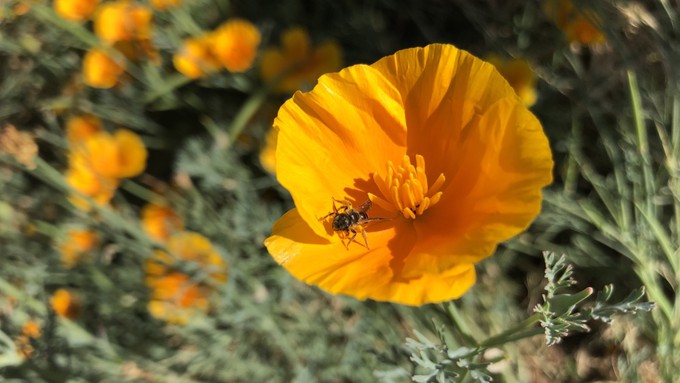
Test your knowledge with a quiz

The California poppy of course is the state flower. It's an important plant for pollinators, including this ligated furrow bee, a type of sweat bee. Kathy Morrison
Through Saturday, it’s California Native Plant Week, and I can’t think of a better time to plant two or 12 or 222 California natives.
These are the plants that grew here before suburbs and urbs, before gardeners from other areas began importing their favorites from other parts of the country or the world. Our native plants are uniquely adapted to our climate and to our native pollinators (including birds).
In the spirit of celebration, I put together a quick (and fun, I hope) quiz on California natives. See how much you already know about them:
1. Which was the first native plant to receive an “official” state designation?
a) California redwood, state tree
b) Purple needle grass, state grass
c) California poppy, state flower
2. The California poppy (Eschscholzia californica), by the way, beat out which other native(s) to win the title of state flower? Choose any that apply:
a) Windpoppy (Papaver heterophyllum)
b) Coulter's matilija poppy (Romneya coulteri)
c) Mariposa lily (Calochortus sp.)
d) Red ribbons (Clarkia concinna)
e) California sunflower (Helianthis californicus)
3. Which of these natives is NOT a ceanothus?
a) Buck brush
b) Coyote bush
c) Deerbrush
d) Oregon tea tree
4. Which native plant has been endangered by poachers in the wild?
a) Bluff lettuce (Dudleya farinosa)
b) Black sage (Salvia mellifera)
c) Desert agave (Agave deserti)
d) Western redbud (Cercis occidentalis)
5. Oak trees (Quercus sp.) are considered a keystone species for California wildlife – important especially for native birds. Which of these oaks is not a native?
a) Blue oak (Q. douglasii)
b) Garry’s oak (Q. garryana)
c) Engelmann oak (Q. engelmannii)
d) Pin oak (Q. palustris)
e) Black oak (Q. kelloggii)
6. California has how many types of native plants, according to the California Native Plant Society?
a) 1,000
b) 2,500
c) 5,000
d) 6,000
Bonus: How can gardeners celebrate California Native Plant Week?
a) Join CNPS or a local chapter (Sacramento Valley for our region)
b) Sign up for the free Gardens Gone Native tour, to be held April 29 in Sacramento and Yolo counties. The self-guided tour will include about two dozen gardens planted primarily with natives.
c) Plant California natives! See the list of suggested plants and participating nurseries at Bloom! California.
d) Visit the UC Davis Arboretum and Public Garden to see its many native plantings. Or shop at the next Arboretum Nursery plant sale, which always includes a variety of natives.
Answers:
1. c) The California poppy became the official state flower in 1903. The redwood was designated in 1937 and the needle grass in 2004.
2. b) and c) They finished far behind in the legislative vote total.
3. b) Coyote bush. Its Latin name is Baccharis pilularis.
4. a) Dudleya farinosa and many other coast Dudleyas are in such danger from succulent poachers that in 2021 Gov. Newsom signed a bill specifically making Dudleya poaching illegal.
5. d) The pin oak is a popular landscape tree in California but it’s an import from the eastern and central United States.
6. d) It’s at least 6,000 and probably higher -- more than any other state. And roughly 40 percent of California’s native plants are found only within its borders.
Bonus: All of the above, of course!
Comments
0 comments have been posted.Sacramento Digs Gardening to your inbox.
Food in My Back Yard Series
May 6: Maintain soil moisture with mulch for garden success
April 29: What's (already) wrong with my tomato plants?
April 22: Should you stock up on fertilizer? (Yes!)
April 15: Grow culinary herbs in containers
April 8: When to plant summer vegetables
April 1: Don't be fooled by these garden myths
March 25: Fertilizer tips: How to 'feed' your vegetables for healthy growth
March 18: Time to give vegetable seedlings some more space
March 11: Ways to win the fight against weeds
March 4: Potatoes from the garden
Feb. 25: Plant a fruit tree now -- for later
Feb. 18: How to squeeze more food into less space
Feb. 11: When to plant? Consider staggering your transplants
Feb. 4: Starting in seed starting
Sites We Like
Garden Checklist for week of May 11
Make the most of the lower temperatures early in the week. We’ll be back in the 80s by Thursday.
* Plant, plant, plant! It’s prime planting season in the Sacramento area. Time to set out those tomato transplants along with peppers and eggplants. Pinch off any flowers on new transplants to make them concentrate on establishing roots instead of setting premature fruit.
* Direct-seed melons, cucumbers, summer squash, corn, radishes, pumpkins and annual herbs such as basil.
* Harvest cabbage, lettuce, peas and green onions.
* In the flower garden, direct-seed sunflowers, cosmos, salvia, zinnias, marigolds, celosia and asters. (You also can transplant seedlings for many of the same flowers.)
* Plant dahlia tubers.
* Transplant petunias, marigolds and perennial flowers such as astilbe, columbine, coneflowers, coreopsis, dahlias, rudbeckia and verbena.
* Keep an eye out for slugs, snails, earwigs and aphids that want to dine on tender new growth.
* Feed summer bloomers with a balanced fertilizer.
* For continued bloom, cut off spent flowers on roses as well as other flowering plants.
* Add mulch to the garden to maintain moisture. Mulch also cuts down on weeds. But don’t let it mound around the stems or trunks of trees or shrubs. Leave about a 6-inch-to-1-foot circle to avoid crown rot or other problems.
* Remember to weed! Pull those nasties before they set seed.
* Water early in the day and keep seedlings evenly moist.